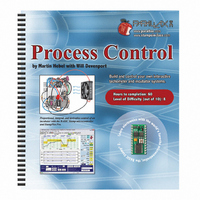122-28176 Parallax Inc, 122-28176 Datasheet - Page 249

122-28176
Manufacturer Part Number
122-28176
Description
GUIDE STUDENT PROCESS CONTROL
Manufacturer
Parallax Inc
Specifications of 122-28176
Accessory Type
Manual
Product
Microcontroller Accessories
Lead Free Status / RoHS Status
Contains lead / RoHS non-compliant
For Use With/related Products
Propeller Education (PE) Kit
Lead Free Status / RoHS Status
Lead free / RoHS Compliant, Contains lead / RoHS non-compliant
- Current page: 249 of 330
- Download datasheet (11Mb)
Part B: Op-Amp Differential Gap Temperature Detection
Instead of the ADC being used to monitor temperature, how could two op-amps be used
as comparators to inform the BASIC Stamp when the actual temperature is above or
below the upper and lower trip points of 102.0 and 101.0 respectively?
CONCLUSION
Hopefully, the data that you have observed and recorded will reveal some important
characteristics of these two control modes. They both have advantages and
disadvantages. Simple On-Off control results in rapid cycling of the heating element.
Reported cycle times of less than one second could easily result if your system has a fast
recovery or there is noise on the analog line. Rapid cycle time would not be acceptable if
our heater were being controlled by an electromechanical relay.
Notice, however, that the overshoot is approximately a half-degree and our average
temperature is at the desired setpoint. Compare this control response to that observed
when Differential Gap has been added to the On-Off control. With Differential-Gap
control, you will notice fundamental differences in the control action.
Increased cycle time and noise immunity around the setpoint are definite improvements
over simple on-off control. The tradeoff, however, is allowing the process to vary further
from the desired temperature setpoint.
Obviously, an understanding of your process and its hardware will determine the
appropriate control mode. Both modes took appropriate control action to maintain
temperature under changing disturbance levels and load conditions. The drawback to
either mode of ON/OFF control is that the controlled variable is constantly on the move.
The fully-ON and fully-OFF conditions of the final control element are continually
forcing the measurement past the limits.
If you recall, in the Open-Loop Control exercises of Chapter 6, a value of drive between
fully-off and fully-on was found to be appropriate to hold the temperature at the setpoint.
√
•
•
•
Draw a schematic and show control code for this.
Rapid cycling about the setpoint no longer occurs.
The minimum and maximum values still overshoot, but now beyond the limits.
Total cycle time between ON and OFF conditions is longer.
Related parts for 122-28176
Image
Part Number
Description
Manufacturer
Datasheet
Request
R

Part Number:
Description:
MANUAL FOR SUMOBOT
Manufacturer:
Parallax Inc
Datasheet:

Part Number:
Description:
GUIDE STUDENT SMART SENSORS
Manufacturer:
Parallax Inc
Datasheet:

Part Number:
Description:
MANUAL PROPELLER
Manufacturer:
Parallax Inc
Datasheet:

Part Number:
Description:
LEAD WIRES FLYING CABLE III/IV
Manufacturer:
Xilinx Inc
Datasheet:

Part Number:
Description:
BOARD ADAPTER AND FLY LEADS
Manufacturer:
Xilinx Inc
Datasheet:

Part Number:
Description:
PLATFORM CABLE USB II
Manufacturer:
Xilinx Inc
Datasheet:

Part Number:
Description:
KIT STARTER COOLRUNNER-II BUNDLE
Manufacturer:
Xilinx Inc
Datasheet:

Part Number:
Description:
Microcontroller Modules & Accessories DISCONTINUED BY PARALLAX
Manufacturer:
Parallax Inc

Part Number:
Description:
Microcontroller Modules & Accessories DISCONTINUED BY PARALLAX
Manufacturer:
Parallax Inc

Part Number:
Description:
BOOK UNDERSTANDING SIGNALS
Manufacturer:
Parallax Inc
Datasheet:

Part Number:
Description:
BOARD EXPERIMENT+LCD NX-1000
Manufacturer:
Parallax Inc
Datasheet:

Part Number:
Description:
IC MCU 2K FLASH 50MHZ SO-18
Manufacturer:
Parallax Inc
Datasheet:












